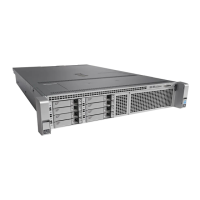• Power on, power off, power cycle, reset and shut down the server
• Toggle the locator LED
• Configure the server boot order
• View server properties and sensors
• Manage remote presence
• Create and manage local user accounts, and enable remote user authentication through Active Directory
• Configure network-related settings, including NIC properties, IPv4, VLANs, and network security
• Configure communication services, including HTTP, SSH, and IPMI Over LAN
• Manage certificates
• Configure platform event filters
• Update CIMC firmware
• Monitor faults, alarms, and server status
No Operating System or Application Provisioning or Management
CIMC provisions servers, and as a result, exists below the operating system on a server. Therefore, you cannot
use it to provision or manage operating systems or applications on servers. For example, you cannot do the
following:
• Deploy an OS, such as Windows or Linux
• Deploy patches for software, such as an OS or an application
• Install base software components, such as anti-virus software, monitoring agents, or backup clients
• Install software applications, such as databases, application server software, or web servers
• Perform operator actions, including restarting an Oracle database, restarting printer queues, or handling
non-CIMC user accounts
• Configure or manage external storage on the SAN or NAS storage
Overview of the CIMC User Interface
The CIMC user interface is a web-based management interface for Cisco C-Series servers. You can launch
the CIMC user interface and manage the server from any remote host that meets the following minimum
requirements:
• Java 1.6 or higher
• HTTP and HTTPS enabled
• Adobe Flash Player 10 or higher
Cisco UCS C-Series Servers Integrated Management Controller GUI Configuration Guide, Release 1.1(2)
OL-22894-01 3
Overview
Overview of the CIMC User Interface

